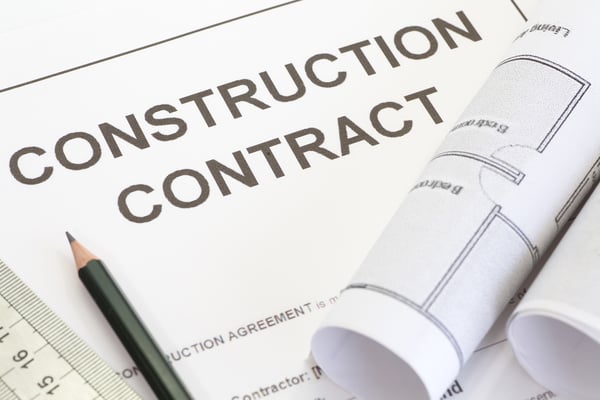Main 4 Types of Construction Contracts

A construction project involves many different parties, including owners, designers, engineers, architects, contractors, subcontractors, and suppliers. Since each party has its own interests, it’s important to create a document that serves protection and guarantees for everyone involved. Construction projects also have many risks, and the document should state how they are distributed.
A construction contract is a document that creates a legally binding agreement between all parties. The purpose of a construction contract is to:
- Distribute responsibilities and duties between parties.
- Risk management: Determine project risks and allocate them among the different parties.
- Reduce uncertainty and clear any doubts regarding the project.
A construction contract also establishes the compensation for the project and how it will be distributed. There are several types of contracts used in the industry, but some specific types are more commonly used in construction: Cost Plus Contract, Lump Sum or Fixed Price Contract, Unit Pricing Contract, and Time and Materials Contract.
Reduce project costs and mitigate risks with effective construction administration.
Construction contracts are usually classified according to the payment terms. Contracts also establish specifications, quality requirements, project schedules, and deadlines. Any type of contract can be customized to meet the specific needs of the project. This article provides an overview of the main contract types used in construction.
Cost Plus Contracts
In this type of contract, the contractor is paid based on actual purchases, labor costs, and other expenses generated from the construction project. The contract includes all direct and indirect costs, plus a specific fee. Cost-plus contracts must detail a pre-negotiated amount that covers the contractor's overhead and profit, also all costs must be described and classified as direct or indirect costs. This type of contract has many variations, and the most common are:
- Cost Plus Fixed Fee
- Cost Plus Fixed Percentage
- Cost Plus with Guaranteed Maximum Price Contract
- Cost Plus with Guaranteed Maximum Price and Bonus Contract
In this type of contract:
- All risk is assigned to the owner.
- The owner is involved in construction administration alongside the contractor.
- In case of increasing project costs, the contractor bears no risk.
- There is no incentive to reduce labor costs by working faster.
- More supervision is required because contractors have little risk and expenses are more difficult to track.
This type of contract is ideal when the project scope has not been completely defined and there is some uncertainty. Contractors can start working on a project before its design is completed.
Lump Sum or Fixed Price Contracts

In this type of contract, the contractor bids a single fixed price for all the activities in the project scope. The contractor estimates project costs from the construction drawings and specifications. Overhead and profit are then added to determine the overall price of the project. The following are some important characteristics of Fixed-price contracts:
- All risk is assumed by the contractor.
- The owner carries no risk.
- The contract can include incentives or benefits for early finish.
- The contract can have penalties for late finish, called liquidated damages.
Lump Sum contracts are ideal for projects with a detailed and well-defined scope and schedule. The project design must also be completed to use this type of contract, since there is limited flexibility for modifications during the construction stage. As mentioned before, in this contract the risk is transferred to the contractor. However, contractors include some percentage costs associated with carrying the risk, which are included in the fixed price.
Unit Pricing Contracts
Unit pricing is commonly used by builders and federal agencies. This contract is based on units put in place rather than a single price, and the payment is determined as a specific rate. For example, the price of a cubic meter of concrete is multiplied by the quantity placed. In this type of contract:
- The contractor prices individual tasks
- The owner can estimate project costs, but the exact cost will only be known until completion.
- The contractor is paid based on the units put in place and verified by the owner.
- Unit prices can be set by the owner during the bidding process. This way, the owner can avoid inflated prices.
- Unit prices can be adjusted based on scope changes.
Unit pricing provides flexibility for differences between the planned and actual work. For this reason, this contract type is commonly used when the quantity of work cannot be established accurately. For example, unit prices can be used for excavation projects that involve soil and rocks, such as highway construction contracts.
Time and Materials Contracts

Time and Material contracts are used when there is no clearly defined scope. In this type of contract, the owner and contractor must agree on a daily or hourly rate, which can include additional expenses that arise during the construction phases. In Time and Material contracts:
- All costs must be included and classified as direct, indirect, overhead, and mark-up.
- Project owners can establish a price cap or specific project duration for contractors, to minimize their own risk.
These contracts are convenient for small scopes, or when you have an accurate estimate of how long it will take to conclude the scope.
Conclusion
Selecting the right type of contract is an important decision in construction projects, since each contract type is suited for different conditions. For example, a fixed-price contract transfers all risks to the contractor, but the project scope and design must be clearly defined to make it viable.
Ideally, a construction contract should accomplish a fair allocation of risks based on the available information. In general, the contractor can assume more risks when information is abundant and detailed. On the other hand, the project owner must assume a higher risk when detailed information cannot be provided to the contractor.
Nearby EngineersNew York Engineers has a MEP design track record of 1,000+ projects. Contact us via email (info@ny-engineers.com) or phone, and make sure your building systems meet codes.

Anuj Srivastava
Anuj Srivastava is a principal partner at NY Engineers. He is known for his MEP franchise market knowledge. Anuj is currently leading a team of 100+ MEP/FP engineers and has successfully led over 1500 franchise projects in the US.
Join 15,000+ Fellow Architects and Contractors
Get expert engineering tips straight to your inbox. Subscribe to the NY Engineers Blog below.



